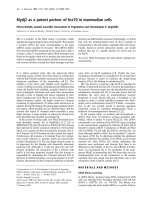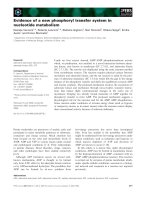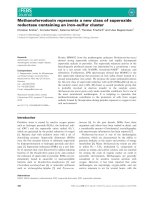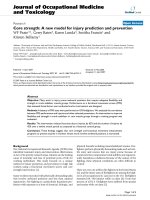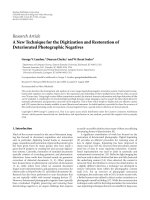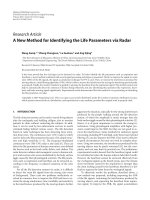Báo cáo y học: "Rasburicase represents a new tool for hyperuricemia in tumor lysis syndrome and in gout Lisa Cammalleri and Mariano Malaguarnera"
Bạn đang xem bản rút gọn của tài liệu. Xem và tải ngay bản đầy đủ của tài liệu tại đây (319.44 KB, 11 trang )
Int. J. Med. Sci. 2007, 4
83
International Journal of Medical Sciences
ISSN 1449-1907 www.medsci.org 2007 4(2):83-93
© Ivyspring International Publisher. All rights reserved
Review
Rasburicase represents a new tool for hyperuricemia in tumor lysis syn-
drome and in gout
Lisa Cammalleri and Mariano Malaguarnera
Dept of Senescence, Urological and Neurological Sciences, University of Catania, Catania, Italy
Correspondence to: Mariano Malaguarnera, A.P., Via Messina 829 – 95125 Catania (Italy). Phone ++39 95 7262008; Fax ++39 95 7262011;
E-Mail:
Received: 2007.01.12; Accepted: 2007.03.01; Published: 2007.03.02
Hyperuricemia is a feature of several pathologies and requires an appropriate and often early treatment, owing
to the severe consequences that it may cause. A rapid and massive raise of uric acid, during tumor lysis syn-
drome (TLS), and also a lower and chronic hyperuricemia, as in gout, mainly damage the kidney. To prevent or
treat these consequences, a new therapeutic option is represented by rasburicase, a recombinant form of an en-
zyme, urate oxidase. This enzyme converts hypoxanthine and xanthine into allantoin, a more soluble molecule,
easily cleared by kidney. The several types of urate oxidase have followed each other, with progressive reduc-
tion of adverse reactions. The most important among them are allergenicity and the development of antibodies
which compromise their effectiveness. Nevertheless, a limit of rasburicase’s use remains its cost, which obliges
to a judicious choice to prevent TLS in high risk patients with cancer and in case of allergy or impossibility to
take allopurinol orally both in TLS and in gout. A large body of evidence confirms the efficacy and safety of
rasburicase, even in comparison to the standard drugs used in the aforementioned pathologies.
Key words: Urate oxidase, allantoin, rasburicase, hyperuricemia, tumor lysis syndrome, acute renal failure, gout, allopurinol,
uric acid
1. Introduction
Uric acid is a weak organic acid (pKa 5.8), poorly
water-soluble at acidic pH. It derives partly from diet
and partly from endogenous biosynthesis and it is
eliminated by enteric (25-35%) and renal (65-75%)
ways. We define hyperuricemia the uric acid blood
level over 8 mg/dl (4.76 µmol/l).[1] The impact of
hyperuricemia is wide felt because it may cause
pathologic consequences in several organs, such as
kidney, brain, subcutaneous tissue, joints. Many stud-
ies underline the direct proportionality between se-
rum urate and risk of gout. [2,3] Hyperuricemia, in
fact, is considered its biochemical hallmark, because
the precipitation of uric acid is possible when uric acid
exceeds the limit of solubility (about 4.20 µmol/l at 37º
C). Gout attack is one of the most painful situations
suffered by humans, [4] owing to the crystallization of
uric acid within joints with the consequent intermit-
tent attacks of arthritis.
The tophaceous gout is the chronic and insidious
evolution that happens after 10 or more years. It is
characterized by the deposition of monosodium urate
(tophi) in soft tissues around joints, in kidney and in
subcutaneous tissue.
Kidney is one of the most involved organs in case
of hyperuricemia, because it is the main site of uric
acid excretion. Its impairment may be of different
types. Hyperuricemia is a cause of urolithiasis. Calculi
predominantly composed of uric acid represent
around 13% of human kidney stones. [5]
It is possible also an acute urate nephropathy,
due to a dramatic and rapid increase of uricemia and
renal handling of uric acid and urate. The crystals pre-
cipitate and obstruct tubules of distal nephrons and
collecting ducts, where pH is acidic. The result is a
tubular necrosis and acute renal failure (ARF) because
of intrarenal obstruction of urinary flow. After the
disruption of the tubules, crystals start to accumulate
in the interstice. Crystallization is worsened by vol-
ume depletion (frequent in neoplastic patients owing
to vomiting, diarrhoea, fever), that compromises
glomerular filtration and increases urate concentration
in distal tubule. Also, low urine pH reduces uric acid
solubility, worsening crystallization. [6]
The most frequent causes of ARF are the cy-
tostatic therapies in patients with cancer or blastic cri-
sis in acute leukaemia. The consequent massive cellu-
lar lysis exceeds the renal excretory ability. ARF is re-
versible with early treatment. Calculi are rarely de-
scribed in this kind of renal damage.
The last type of renal damage is “gouty
neph-
ropathy”, occurring when hyperuricemia is persistent
but mild. In the interstice and in some tubules we can
find precipitated microcrystals, which lead a chronic
inflammation, evolving to arteriolosclerosis, tu-
bulo-interstitial fibrosis, glomerulosclerosis [7] and so
to chronic renal failure.
Hence, in this paper we review a drug that
quickly reduce uric acid levels, especially in emer-
Int. J. Med. Sci. 2007, 4
84
gency situations, such as tumor lysis syndrome (TLS),
and discuss possible options for using this drug also
in chronic conditions, such as gout.
2. Uric acid synthesis
The starting point of uric acid synthesis is the ri-
bose–5–phosphate, a pentose derived from glycidic
metabolism, converted to PRPP (phosphoribosyl py-
rophosphate) and then to phosphoribosilamine, that
will be transformed into inosine monophosphate
(IMP). From this intermediate compound derive
adenosine monophosphate (AMP) and guanosine
monophosphate (GMP), the purinic nucleotides useful
for DNA and RNA synthesis, and inosine that will be
degraded into hypoxanthine and xanthine and finally
into uric acid.
Hypoxanthine and guanine may enter in a sal-
vage pathway, using hypoxanthine-guanine phospho-
ribosyltranferase (HGPRT), an enzyme that reconverts
these purines bases into respective nucleotides. (Table
1)
In humans and other primates, urate oxidase
(uricase), a hepatic enzyme, is inactive as a result of a
non-sense mutation, originating a stop codon. So, only
animals which possess uricase are able to transform
uric acid in a more soluble (5 – 10 times more than uric
acid) and more eliminable molecule: allantoin. A side
product of this reaction is hydrogen peroxide, toxic for
kidney, that is converted in H
2
O and O
2
by catalase. A
hypothesis considers this mutation as a result of phy-
logenetic evolution, because uric acid has antioxidant
properties, that protect against neurological degenera-
tive diseases, and increases longevity. [8] Yet, the loss
of this enzyme arises the consequences derived from
uric acid poor solubility. Mice with gene inactivation
of urate oxidase have hyperuricemia and renal tubu-
lopathy. [9]
In the past, this alternative metabolic pathway,
absent in men, was exploited in order to reduce uric
acid levels by making a kind of substitutive therapy.
Standard drugs used to prevent and treat hyperu-
ricemia may be burdened by several effects that re-
duce efficacy and safety.
This objective has been achieved with the syn-
thesis of uricase.
3. Urate oxidase history
The first molecule of this kind, synthetized in
1968 and introduced in France since 1975 and in Italy
since 1984, was a non-recombinant urate oxidase. [10]
It was a natural uricase, obtained from Aspergillus fla-
vus cultures (Uricozyme
TM
), used to prevent and treat
hyperuricemia occurring during chemotherapy. [10]
Its slow and poor production and its scarce pu-
rity were the main limits of its use.
Its proteic nature, the poor accurate process of
purification and the administration of a molecule, ge-
netically absent in humans, made hypersensitivity
reactions very probable, even in patients without his-
tory of allergy. Immunogenicity and hypersensitivity,
in fact, were due to the great number of impurities in
the preparation.
Immunogenicity might have caused the produc-
tion of antibodies with possible reduction of drug ef-
ficacy. Hypersensitivity presented with rashes, bron-
chospasm, urticaria and angioedema in about 5% of
patients. Allergic reactions occurred within 1-17 min-
utes after the beginning of the first infusion. [10]
Since 1996, the molecule currently used, rasburi-
case (Fasturtec
TM
in Europe, Elitek
TM
in USA) is ob-
tained by recombinant DNA technique. A genetically
modified strain of Saccharomyces cerevisiae expresses
urate oxidase cDNA, cloned from a strain of Aspergil-
lus flavus. [23] It allows to obtain urate oxidase more
rapidly and in a larger quantity. Also, rasburicase is
purer with higher activity than non-recombinant urate
oxidase. During the production process the molecule
and its structure are totally conserved.
A modification of a reactive cysteine, obtained
during the purification process of non-recombinant
urate oxidase, and the higher purity of rasburicase
may explain the differences between the old and the
new urate oxidase. [12]
In fact, the old and the new urate oxidase do not
significantly differ from a pharmacodynamic point of
view; the only difference consists in the reduction of
rasburicase’s adverse effects. Studies have reported
the presence of antibodies antirasburicase in some pa-
tients [13], whilst others reported no development of
antibodies after several days of therapy.[14]
Four monomers (of a molecular mass of 34 kDa
each) form rasburicase, that is currently classified as
detoxifying agent for antineoplastic treatment. Its use
in other hyperuricemic conditions, such as chronic
gout, is difficult, because rasburicase has a short
half-life, which requires a daily administration. So,
PEGylation technique has been proposed to prolong
half-life and further reduce immunogenicity.
The PEGylation consists in binding with a cova-
lent link a protein (adenosine-deaminase, asparagi-
nase, interferons, granulocyte colonystimulating factor,
liposomal doxyrubicin) to poly(ethylene) glycol. It
permits to obtain molecule with prolonged half-life
(terminal half-life between 10-20 days) and thus a
weekly administration. The PEGylated form of ras-
buricase, a bacterial urate oxidase, was used the first
time in 1988 to treat a nephropathy induced by uric
acid in a case of non-Hodgking lymphoma. [15] Then
PEG-uricase was proposed for cases of uncontrolled
gout or for intolerance or not compliance to standard
therapy. [16] It was a mammalian, recombinant urate
oxidase, modified with monomethoxy-PEG.
[9] The
use of non-modified, recombinant mammalian uricase
is impossible, because of its immunogenicity and in-
effectiveness in decreasing uric acid levels. [9] Al-
though PEGylation is a process that could reduce hy-
persensitivity reaction, the development of antibodies
has been reported. Nevertheless, it could resolve
spontaneously during the treatment. [16]
So, maintaining the same efficacy of rasburicase,
the advantages of PEG-uricase may be: lack of anti-
genicity, absence of side effects and a longer duration
of activity.
Int. J. Med. Sci. 2007, 4
85
4. Rasburicase pharmacokynetics
Information about pharmacokinetics derives by
the use of rasburicase in children and young adults.
Few data are available in adults and elderly. [17]
The distribution volume is similar to the physio-
logical blood volume. It is administered once a day,
being the half-life is 19 hours. Steady state is achieved
in 2-3 days. Even after 5 days of treatment, a consis-
tent accumulation has not been reported. [13] Interac-
tion studies have been performed in vitro where ras-
buricase does not show interaction with other drugs.
Association between rasburicase and allopurinol
should be avoided, because the latter may reduce the
effect of rasburicase owing to its inhibition of xanthine
oxidase and consequent reduced uric acid concentra-
tion. [18]
Studies about metabolism have not been per-
formed but as other protein, rasburicase metabolism
occurs by peptide hydrolysis, so liver should not be
involved and the cytochrome P450 is not inducted or
inhibited; so even hepatic pathologies do not require
an adjustment of dosage. [10] Its clearance does not
depend on renal function.
5. Rasburicase pharmacodynamics
It is an enzyme whose action consists in catalyz-
ing the oxidation of uric acid into allantoin, rapidly
excreted by the kidneys. Allantoin is poorly toxic and
easy cleared, also in cases of renal impairment. The
reaction occurs through an intermediate, 5- hydroxy-
isourate, that will be converted into allantoin with a
non-enzymatic degradation. [19] This reaction releases
a molecule of hydrogen peroxide, an oxidant product,
that human anti-oxidant system (catalase) neutralizes
producing water and oxygen. Subjects with a glucose
6 phosphate dehydrogenase deficiency are lacking in
antioxidant systems, so they do not detoxify hydrogen
peroxide. Rasburicase is contraindicated in these pa-
tients.
Rasburicase recommended dose is 0.20
mg/Kg/die diluted in 50 ml of sodium chloride solu-
tion (0.9%), administered intravenously in 30 minutes,
daily or twice daily for 5-7 days. Hence, a large num-
ber of studies have tested different doses, even lower
than standard dose and for shorter period than rec-
ommended. [20] A single dose of rasburicase, at low
dosage, has showed a rapid reduction of hyperurice-
mia. [21-24] Contemporary use of alkalinization, hy-
dration and rasburicase at 0.10 mg/kg for 3-5 days
maintains the same efficacy. [25] Anyway, we may
have favourable issues by changing the dose of ras-
buricase, according to the various clinical states, the
type of malignancy and drugs used. The use of low
doses of rasburicase may permit to spare the total cost
on the management of patients and to reduce the risk
of the development of antibodies.
6. Clinical use
Tumor Lysis Syndrome (TLS)
Already before 2002, when Food and Drugs Ad-
ministration (FDA) of US has approved the use of
urate oxidase for the management of paediatric pa-
tients at risk for TLS (Tumor Lysis Syndrome) [26],
urate oxidase was used for this purpose with good
efficacy. [13,14,27-30] Currently US FDA does not ap-
prove its use in adult, instead EU FDA has approved it
in children and adult. [19]
Tumor lysis syndrome (TLS) is a spontaneous
condition (present in haematological malignancies and
other conditions) or, more frequently, occurring in
consequence of chemotherapy, radiotherapy or im-
munotherapy. [6,19,31] It is characterized by massive
and rapid cellular lysis with consequent release of in-
tracellular molecules, a condition that raises the risk of
morbidity and mortality, even in patients potentially
curable. TLS is defined as the presence of at least 2 of
the following laboratory data: hyperuricemia, hyper-
kalemia, hyperphosphatemia, and secondary hypo-
calcemia as described by Cairo- Bishop criteria. [1]
According to these criteria, the levels of these abnor-
malities must draw away 25% from baselines or ex-
ceed the threshold value showed in table 2. (Table 2)
Hyperuricemia is very common in patients with
a neoplastic disease and it is already present at the
diagnosis or it develops within 48-72 hours after the
treatment.
The greater is the growth rate of tumor, the
higher is the content of DNA and consequently of uric
acid produced. When uric acid exceeds renal capacity
of elimination, it precipitates into renal tubules. So, a
vicious circle creates because the consequent renal
functional impairment worsens hyperkaliemia and
hyperphosphatemia, phosphorus and calcium bind
themselves and precipitate within kidneys. (Figure 1)
These metabolic abnormalities are more harmful
in neoplastic patients, since their general conditions
are already compromised by cachexia, malnutrition,
pain. It is an imperative treating or, better, preventing
TLS, because each metabolic derangement is associ-
ated with remarkable clinical manifestations.
Hyperuricemia and hyperphosphatemia severely
worsen renal functionality; hyperkalemia and hypo-
calcemia compromises regular cardiac rhythm causing
arrhythmias, sometimes mortal, and neuromuscular
function, with potential tetany, convulsion, cramping.
[32] Being the clearance of uric acid, potassium, cal-
cium and phosphate mainly renal, kidneys are over-
loaded, until their excretion ability is saturated with
great difficulties to eliminate electrolytes, toxic sub-
stances and drugs, with consequent risk of accumula-
tion and toxicity. Uric acid can determine the renal
impairment in different ways: the local and direct ob-
struction and toxicity on tubules and the local and
systemic inflammation. Other factors may contribute
to pathogenesis of ARF: the nephrotoxicity of some
chemotherapeutic, antibiotics, antiviral and antifungal
drugs [25], kidney obstruction or compression or renal
vascular thrombosis in solid tumors. (Figure 2) It is
necessary to underline that rasburicase controls hy-
peruricemia, but it has not direct effect on the other
metabolic abnormalities, that will be treated with spe-
cific measures.
Int. J. Med. Sci. 2007, 4
86
TLS has been reported in association with several
tumors: haematologic malignancies and bulky solid
tumours. [32,33-35]
The efficacy of rasburicase in the prevention and
treatment of TLS has been studied by several authors
who have demonstrated its effectiveness, despite its
extremely high cost. A Pan-European multicentre
study has weighed the cost-effectiveness ratios of
preventing and treating TLS with rasburicase, in hae-
matological malignancies, both in children and adults
with the conclusion that rasburicase remains a useful
drug clinically effective and in addition with a fa-
vourable economic outcome in the treatment of hype-
ruricemia. In prevention, instead, its cost-effectiveness
is favourable in children with all type of haematologi-
cal malignancies and in adults with acute lymphoblas-
tic leukaemia and non-Hodgkin lymphoma, but lower
in acute myeloid leukaemia because of short average
life expectancy. [36]
Rasburicase effectiveness and safety should per-
mit us to spare money from the treatment of conse-
quences of cytoreductive treatments and haemodialy-
sis.
Therefore, this drug is effective and safe,
[13,18,20,37-39] but because of its cost, its use is justi-
fied only in some groups of patients which are at risk
for TLS or have TLS and are allergic to allopurinol or
cannot ingest it orally. The risk-factors can be related
to the tumour or to the subjects with cancer (Table 3).
[19,40,41] Patients in who we may consider the use of
rasburicase, owing to risk of TLS, are those who have
hyperuricemia, high tumor burden, high growth rate
of tumor, high sensitivity to chemotherapy and renal
impairment.
Standard measures to prevent and treat hyperu-
ricemia include allopurinol and alkalinization, associ-
ated with an aggressive hydration. Rasburicase pre-
sents various features that give it a more favourable
profile than standard drugs used for TLS. The classic
approach to TLS fails in prevention of acute renal fail-
ure in over to 25% of patients. [42]
Gout
Even though rasburicase is approved for treat-
ment and prophylaxis of acute hyperuricemia in hae-
matological malignancy with a high tumour burden,
in order to prevent acute renal failure, it has been used
for other purposes.
Life style changes (resulting in obesity), a protein
richer diet, longevity and the use of some drugs (diu-
retics) have caused an increase of some pathologies,
such as gout. It affects at least 1% of Western popula-
tion. [43]
Rasburicase may be able to dissolve tophi in
therapy-resistant tophaceous gout. [44,45]
Allopurinol is frequently used in cases of tophi,
frequent attack of arthritis or urolithiasis. [43]
Rasburicase is a potential alternative especially
when allopurinol could not be used because of allergy
or failure. Uricase reduces tophi volume and generates
allantoin, which is easily excreted by kidneys, even in
cases of chronic renal damage. [16] The involvement
of kidney, frequent in tophaceous gout, in fact, makes
difficult the use of allopurinol, whose excretion is
mainly renal. Its dosage should be reduced or discon-
tinued with consequent possible rise of uric acid and
acute arthritic attack.
PEG-uricase, the long-acting form, seems to bet-
ter control gout that non-pegylated form. The need for
a daily administration and the increased probability of
development of hypersensitivity with re-treatment
make the use of non-modified rasburicase difficult in
case of gout. [16]
PEG uricase accelerates potently tophi dissolu-
tion in 3 month, [46] while they remained stable or
were partially eliminated with standard therapy. A
trial, in which PEG-uricase was administered subcu-
taneously in patients with severe, refractory gout at
doses between 4-24 mg in a single dose, has showed a
reduction of uric acid pool until 21 days. [16]
Moreover, rasburicase has been effectively em-
ployed in transplanted patients with gout, where al-
lopurinol in association with azathioprine or cyc-
losporine is contraindicated for the risk of leukocyto-
penia. [47,48]
Azathioprine is converted into mercaptopurine
that is metabolized by xanthine oxidase into inactive
compounds, so the concomitant enzyme inhibition by
allopurinol causes a conspicuous increase of mercap-
topurine bioavailability, myelotoxicity and risk of
death. The association between allopurinol and im-
munosuppressive drugs, antineoplastic agent
(6-mercaptopurine), anticoagulant dicumarol, thiazide
diuretics, aluminium hydroxide, should be avoided or
reduced doses of antineoplastic or immunosoppres-
sive or other drugs should be used. It implies a major
risk of unsuccessful control of tumor or transplant re-
jection.
A patient who requires the coadministration of
this kind of drugs, risks a major toxicity, with conse-
quent need of alternative drugs.
Although allopurinol is usually well tolerated, it
may cause adverse effects that need a discontinuous
use, in about 20% of patients. [49] Oxipurinol inhibits
xanthine oxidase too and is an alternative to allopuri-
nol, but an allergy to allopurinol is a contraindication
to its use, owing to cross-allergies between them. [50]
Parental administration, risk of development of
antibodies and the cell transformation in vitro stimu-
lated by hydrogen peroxide [51] are still limits to us-
ing rasburicase. Currently it is employed in clinical
trial where the selected patients with severe and to-
phaceous gout are intolerant, allergic, or
not-responsive to standard therapy.
Future perspectives for gout are new xanthine
oxidase inhibitors, including febuxostat, a nonpurine
analogous, whose metabolism is mainly hepatic, and
that reduces acid uric levels also in patients with renal
impairment. [52]
7. Advantages of rasburicase
Rasburicase reduces uric acid levels within 4
hours both in paediatric and adults patients, so a
Int. J. Med. Sci. 2007, 4
87
mounting body of evidence confirms its effectiveness,
tolerability and safety in the prevention and treatment
of TLS. Table 4 reports some studies that demonstrate
the efficacy of rasburicase.
Rasburicase is very efficacious in the reduction of
the risk of renal damage during chemotherapy; it can
dissolve uric acid crystals and can improve renal func-
tions, permitting to continue chemotherapy. [54,55]
The use of rasburicase is a good option, sometimes
better than use of allopurinol in patients with severe
acute hyperuricemia. Allopurinol is a structural
analogous of hypoxanthine, inhibitor of xanthine oxi-
dase, the last enzyme involved in uric acid synthesis
pathway. It catalyzes the conversion of hypoxanyhine
into xanthine and this latter into uric acid. During this
reaction an active metabolite, deriving by enzymatic
action on allopurinol, oxypurinol, inhibits xanthine
oxidase and probably it is responsible for some ad-
verse effects. (Table 5) Moreover, oxypurinol has an
elimination half-life between 18 – 40 hours, depending
on renal function (whereas 0.67-1.5 for allopurinol)
and its concentration increases after protracted ad-
ministration. [56,57] So owing to its activity, its long
elimination half- life and its urine excretion, it requires
a dosage reduction, in case of renal impairment.
Allopurinol action is rather slow in reducing uric
acid concentration, because acts on the new synthesis
of uric acid, not on pre-existing uric acid. Hence, sev-
eral days are necessary for before uric acid levels to
decrease. The maximum effect appears within 14 days.
[58]
Pharmacokinetics and pharmacodynamics of
allopurinol is different according to aging: its renal
excretion tends to decrease in elderly, [59] so the tol-
erance to its drugs may progressively decline.
The use of allopurinol may be complicated by the
development of nephropathy, rarely reported in lit-
erature, [60] due to its mechanism of action that leads
to an increase of hypoxanthine (more water soluble
than uric acid) and xanthine (less water soluble than
uric acid) concentrations and their precipitation in
tubules. [61]
The incidence of acute hyperuricemic nephropa-
thy has become rare using rasburicase. [62]
Adverse effects of allopurinol are skin rashes,
pruritus, nephropathy, diarrhoea, headache that often
require the discontinuation of the medication (5% of
patients). [49] A severe but rare side effect is hyper-
sensitivity reaction with high-grade fever, bone mar-
row involvement, hepatic and renal toxicity, systemic
vasculitis, exfoliative dermatitis. [63] This syndrome is
more probable in patients who are retreated with al-
lopurinol, after the discontinuation for skin rashes. [50]
As explained, allopurinol action is delayed, because it
acts on uric acid synthesis. In an oncologic emergency
condition, such as TLS, we need a drug, as rasburicase,
with rapid onset of action.
A comparison between rasburicase and oral al-
lopurinol has showed the major efficacy of rasburicase
in controlling hyperuricemia in children with a reduc-
tion in serum levels within 4 hours after the first dose
(-86% rasburicase vs -12% allopurinol). [14]
Moreover, rasburicase has different features that
give some advantages, in comparison with allopurinol;
many of these features are showed in table 6.
[10,13,54,60]
For these reasons, allopurinol remains an alter-
native when rasburicase is contraindicated (allergic
reactions, glucose – 6 – phosphate deydrogenase defi-
ciency) or when TLS risk is low. [1]
Rasburicase is a good option also in comparison
with hydration and alkalinization, that are the stan-
dard proceedings of TLS management.
Hydration, that should be started before and
continued for several days after the end of chemo-
therapy, helps to dilute the excess of substances, to
excrete them by an adequate urinary filtration rate
and to prevent acute urate nephropathy, increasing
intravascular volume. Hyperidration consists in a
2.5-3 litres/m
2
/day liquid administration. [41]
Hydration is a dangerous measure in patients at
risk of volume overload and pulmonary edema: eld-
erly or subjects with cardiovascular, renal or hepatic
diseases.
The use of alkalinization, with infusion of so-
dium bicarbonate, and oral acetazolamide, during
chemotherapy is justified because it facilitates clear-
ance of uric acid and neutralizes the tendency to low-
ering of pH in patients with vomiting and diarrhoea.
It increases solubility and renal excretion of uric
acid and xanthine, maintaining urinary pH between
7.0 and 7.3. Nevertheless, if pH exceeds 7.5, precipita-
tion of calcium phosphate occurs, with worsening of
hypocalcemic symptoms. Rasburicase does not require
alkalinization [26] even though the use of this practice
remains a doubt. It may increase acid uric clearance,
but with a major risk of calcium phosphate precipita-
tion [10] and alteration of blood pH.
Neither patients treated with non recombinant
urate oxidase nor those treated with rasburicase re-
quire dialysis. [13,54]
A retrospective comparison study between Al-
lopurinol and Uricozyme
TM
has showed, in fact, that
Uricozyme
TM
was more effective and rapid in control-
ling hyperuricemia, urea nitrogen and creatinine lev-
els, eliminating need for dialysis. [54]
Urate oxidase in the prophylaxis and treatment
of hyperuricemia and TLS reduces metabolic and re-
nal complications and need for dialysis, which is more
frequent in patients who receive allopurinol than ras-
buricase (16% vs 2.6%). [27] Other studies do not cor-
relate need for dialysis with use of rasburicase. [64,65]
In Goldman’s trial, among patients treated with ras-
buricase, none required dialysis. [14] Among 100 pa-
tients with non Hodgink lymphoma, treated with
rasburicase, during the first cycle of chemotherapy,
none required dialysis and normalization of uric acid
levels and control of creatinine levels were achieved.
[66]
The absence of needing for dialysis is an advance
in comparison with other regimes that do not use
rasburicase, whose need is more remarkable. [67]


